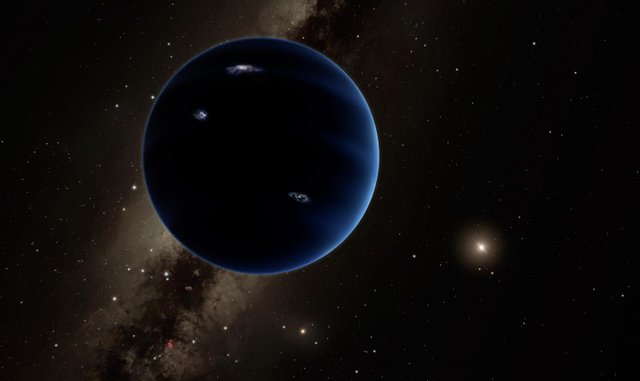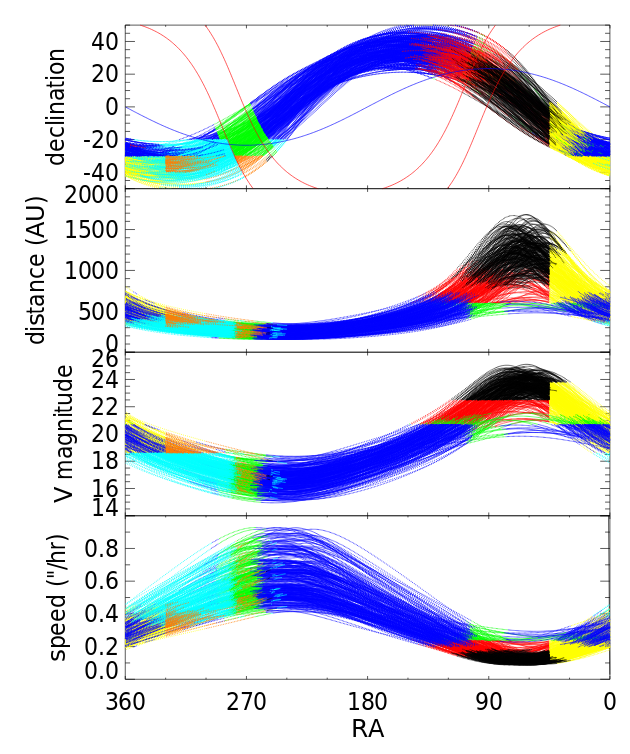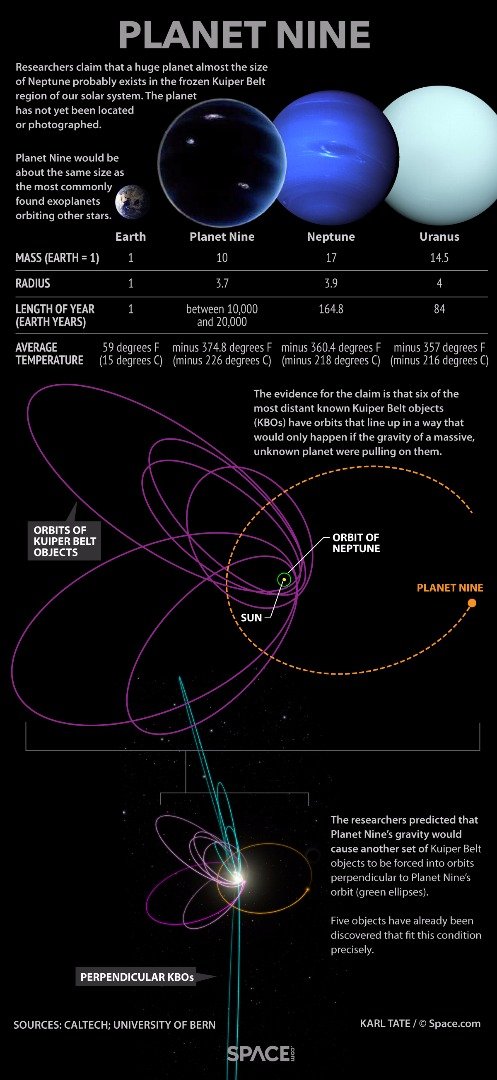Ninth planet search
It has been around years after the Caltech scientists published findings showing that the solar system on the edge of a possible ninth planet exists. During that time, published several dozen scientific papers and was taken numerous reports on the probable planet properties, its origin, the impact on the rest of the solar system, and searches. What we learned from them?

The artist imagines the ninth planet around this. © Caltech / R. Hurt
Planetary properties. The first discovery was made on the basis of a number of distant small solar system bodies orbits properties. These orbits are suddenly like, if someone would whip them into very close trajectories. One possible explanation for such conduct - 700 astronomical units (1 AU - the distance from the Sun to the Earth, is approximately 150 million. Kilometers) away from the Sun distant planet, whose mass is at least 10 Earth masses. Read more about this discovery , I wrote a year ago .
After a couple of months by the same authors published a digital simulation results , which tried to identify the likely characteristics of the planet. In these models, changing the planet's mass and orbital parameters - orbit big Pusa which roughly corresponds to the average distance from the Sun and the orbit ellipticities - authors searched configurations that compressed small bodies orbits as observed, but noticeably does not affect the other planets orbit (because if the orbit is affected, it's about the ninth planet's existence we knew already in place). The results confirmed previous estimates and revised: the planet's mass could be between 5 and 20 Earth masses, and the most probable value is about 10 Earth masses. Orbital ellipticities the higher, the higher the major axis. The most probable value of the three parameters - 10 Earth masses, major axis of 600 AU, ellipticities (maximum and minimum distance from the Sun, and the difference between the ratio of the sum) - 0.5. In this case, the smallest planet's distance from the Sun to 300 AU, the largest - 900 AU. These orbital parameters can be compared to other objects in the solar system: Pluto is the farthest from the Sun departs within 50 AU, which, on average, at a distance of 40; universally recognized as the outermost dwarf planet Eris, respectively, through 98 and 68 of the AU; perhaps the outermost dwarf planet - over 936 and 506 AU (it detected only because it is now very close to the Sun, only 85 AU). Thus, the ninth planet really is not the extremity of the object in the solar system, but the empty space between it and the other eight planets - giant.
The most probable mass of the planet - ten Earth masses - is slightly smaller than Uranus and Neptune (14 and 17 below). Thus, the ninth planet may be similar to the two - a solid core surrounded by a thick layer of water ice and dense gaseous atmosphere. On the other hand, it can be similar to Earth, that is mainly made up of rocks, with a relatively insignificant atmosphere. To determine which of these two models of the structure is correct, it will be possible only when we will measure the planet's radius, since glacial planet radius is significantly higher than the same mass of Rocky.
The same article examined and the ability to detect this planet. According to the most probable orbital parameters calculated where the sky could be seen in it and what is its magnitude. A large part of the sky was observed in a variety of telescopes, making sightseeing sky photos. If the planet is somewhere in those pictures, it probably would have already discovered, especially if the same local sky photos are made by more than one, and the overview and monitoring for staying. Taking all sightseeing observation of the sky surveyed revealed that the planet left to hide a lot of space. The following illustration shows where the planet would be judging from the results of the numerical model (thick colored band) and where it already would they have found (all colors except black, yellow and red). Yellow and red marked regions of the planet can be found presently under observation, and the black region of the detection is not yet as, basically because we have not sufficiently sensitive sightseeing telescopes (third graph shows the planet magnitude - as it is, the planet dimmed; as we can see, the current observation does not reach higher than 22 nd magnitude, while in orbit of the planet can be dimmed).

Available ninth planet positions (top graph), the distance from the Sun (second graph), bright V Photometric band (third graph) and optical speeds sky (lower graph). Taken from the Brown & Batygin 2016th
Does this mean that if you have not detected the planet, and has not found it? Not necessarily. In particular, it is necessary to analyze the existing observational data. Although they detected the planet, but they did not look there's nothing special. If the whole planet is on the detection (Telescope opportunities) range, it could go unnoticed, but a detailed analysis of the planet may be able to find you. If the planet is already available data, and is not, it is possible to direct a telescope to the sky part, where it can still hide and watch it, namely the search for the planet. As soon as the end of last year, and it began to be made - in the Subaru telescope in Hawaii directed to look for the ninth planet .
Effects of solar system. Another digital models forecast - the planet's orbit should be relatively large angle to the ecliptic plane. It is a moving planet can significantly affect other objects in the solar system orbit. About one impact orbits of objects already wrote above - on the impact of this and talk about the planet's existence. But others in the outskirts of the solar system objects can be thrown into orbit, perpendicular to the plane of the solar system. This was written and first article about the planet, and the middle of last year reported several newly discovered objects, with a high angle of inclination to the ecliptic plane . It is not that their orbits affected by the ninth planet, but it can really be.
One of the more interesting effects examined in the second half of the year. It turns out that during the four and a half billion years inclined ninth planet's gravity may have other planets orbits grab the side of the plane in which they were formed . This may explain the discrepancy between the solar rotation around its axis and the plane of the solar system planets mid-plane of rotation. This discrepancy reaches six degrees and yet fail to explain it, since the planet formed from protoplanet drive, which strongly interacted with the Sun, so the two rotation planes should coincide. Ninth planet perturbation solves this problem.

Ninth planet properties and evidence of its existence. © Karl Tate
The origin of the planet. Planetary, especially massive existence so far from the Sun asks a lot of questions. "How to detect it and what effect it has the rest of the Solar System" - two such issues. The third very important issue - how the planet got there? ". There are three possible explanations: it is there and has formed, or it has formed much closer to the Sun and then migrated away; or it caught the sun on the other through the country thrown stars.
Formation location. Protoplanet drives sometimes stretches a thousand astronomical units from its star. But the ends of more than 100 on the star AU normally composed entirely of gases and have practically no dust, which may get down to each other and form the rock, and then - the planets. However, last year proposed a model as possible to overcome this problem: If protoplanet disk disappears from the center to the outside, for example on the star radiation-induced heat, dust and small stones can migrate to the edge of the disc. There, for example 250-750 AU from the solar mass stars, clustered stones gradually form the larger structures. If gravitationally dominant structures formed only a few of its more than 100 million. - 1 billion. years can turn into a planet. The drive loss from the inside out gives the time to the formation of the planet. So far as emerging planets around other stars were not determined, but even if they are, to find them will be difficult due to the large distances and low light. It remains to wait and hope.
Migration from disk inside. Many exoplanets systems have at least one Super Low - rocky planet, the mass of which does not exceed ten Earth masses. The solar system is an exception in this respect, but there are scientists who believe that this was not always the case. It may be that the solar system in his youth around our star was formed at eight, and at least nine massive planet, and at least one of them was later lighted out . It has long been believed that Jupiter and Saturn's gravity could have a significant impact on the solar system configuration, but in terms of planetary ejection, it was claimed that lighted planet completely leave the solar system. This situation is much more likely than the planet to remain in the outskirts of the solar system, but the latter option is also possible, especially if the planet is propelled more or less disk plane while moving and interacting with it. Interaction also reduces the planet's orbit ellipticities, so within a few hundred million years of the planet's orbit can settle this, which is now showing in the latest models.
Catched exoplanet. Neither the formation of the planet, where it now hope to find than migration from the central part of the disc protoplanet model is not very likely. So next to them in another, also not very likely, but possible hypothesis - perhaps the ninth planet was formed at the other stars, and the sun it hijacked ? The sun, like almost all the other stars, formed a cluster and the first few hundred million years had close neighbors, much closer than is now Proxima Centauri. If one of them had a planet, a remote through at least 100 AU, and moved closer to the Sun during about 1000 AU, the planet was able to escape from the first stars and begin to rotate around the sun. After introduction of many possible interactions revealed that a number of interactions in a hundred at the end, the sun begins to revolve around a new planet, the orbit of the ninth planet in line with the expected parameters. Combining these results with estimates of how many stars have planetary systems and the number of interactions could experience the sun, the result is that the probability of the sun to catch the ninth planet from the other stars is 0.01-1%. Not very much, but not negligible.
And here was recently published in a slightly different calculation results. They simulated what would happen if the solar system through planet apostate. Such planets that may have formed the stars, but later lost, and maybe a whole formed in interstellar space, run around the galaxy. Several of them are known, but this is likely to be numerous. Thus, 40% of the cases, when the solar system through the rush of free-riding, it remains somewhere on the edge of the solar system . Since we do not know how many of these planets is a galaxy or solar environment, it is impossible to say these results and the probability that the ninth planet is caught free-riding, but such a scenario is also possible.
Summary. One of the ninth planet's existence model offered to Caltech astronomer Mike Brown, also said in October that the next sixteen months, the planet will be found , or it is proven that it does not exist. Now wait just stayed least twelve months. As ninth planet search, it appears that about the solar system has a lot to know. And it will take more than a decade, maybe a century, until we find out what really is going on its fringes.
Do you mind sharing your sources with us? I do not understand several part of this text, the English being quite hard to read and some words being non-existing (what is a Pusa, what is the mass of Rocky, etc...). Moreover, you mention an article you wrote one year ago:
Please share it :)
In any case, do you mind providing a link with your sources, both for the text and the images. Thanks in advance for your consideration.
Only here to plagiarize !cheetah ban
Congratulations @tiffany123! You have received a personal award!
Click on the badge to view your Board of Honor.
Do not miss the last post from @steemitboard:
SteemitBoard World Cup Contest - The results, the winners and the prizes
Congratulations @tiffany123! You received a personal award!
You can view your badges on your Steem Board and compare to others on the Steem Ranking
Vote for @Steemitboard as a witness to get one more award and increased upvotes!